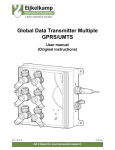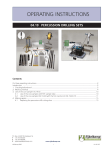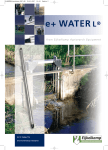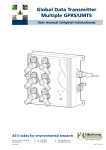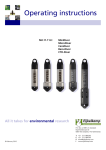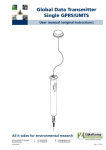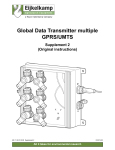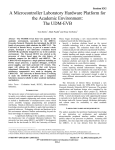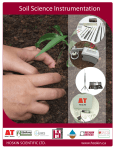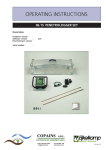Download OPERATING INSTRUCTIONS
Transcript
OPERATING INSTRUCTIONS 04.23 SEDIMENT CORE SAMPLER, TYPE BEEKER Contents About these instructions for use ....................................................................................................................... 2 1. About the sediment sampler and the instructions ........................................................................................ 2 2. Preparing the sampler for use ...................................................................................................................... 3 3. Using the sampler ........................................................................................................................................ 5 4. Taking the sample ........................................................................................................................................ 7 5. Further processing of the sample ................................................................................................................. 9 6. Extra options with the extended set 04.23.SB ............................................................................................ 10 6.1 The hydraulic extrusion system ........................................................................................................ 10 6.2 Working method in the field ............................................................................................................ 11 6.3 Dividing the sample into smaller tubes ............................................................................................. 13 7. Maintenance ............................................................................................................................................. 16 7.1 General maintenance ...................................................................................................................... 16 7.2 Maintenance of taps and connectors ............................................................................................... 17 7.3 Replacing cutting ring and/or membrane in the cutting head ........................................................... 17 7.4 Replacing hose on cutting head ....................................................................................................... 20 P.O. Box 4, 6987 ZG Giesbeek, NL T +31 313 880200 F +31 313 880299 E [email protected] © February 2005 www.eijkelkamp.com 1 M1.04.23.E About these instructions for use When the symbol shown on the left is placed before a piece of text, this means that an important instruction follows. ! When the symbol shown on the left is placed before a piece of text, this means that an important warning follows pointing out a risk of injury to the user or damage to the device. 1. About the sediment sampler and the instructions The instructions have a strong visual orientation. This makes it possible to start work with the sediment core sampler quickly. The first section consists of instructions that apply to both sets (04.23.SA basic and 04.23.SB extended set). This is followed by the extra possibilities offered by the extended set (04.23.SB). The sets are intended for a maximum sampling depth of 5 metres. This depth can be increased by adding extension rods. Taking samples in flowing water becomes difficult or even impossible at a depth of just a few metres. However, the bed will be extremely stony in fast flowing water. The sampler is not intended for this. The piston that moves the sample into the tube and the possibility of hammering mean that in a sandy or other firm bed, a sample of 50150 cm can easily be taken. Bear in mind that driving in the sampler involves a substantial thrust. This means that withdrawal can be difficult or risky, especially from a small boat (danger of capsizing). Fixing the boat in place in relation to the bed using two anchors or spuds is necessary at all times to prevent twisting of the sediment cutter. First read through these instructions completely. Then take the materials and set to work, following the instructions step by step. Each illustration with explanations starts by stating in italics what equipment you need, including any additional items. A few days before going to the work location, charge the batteries of the pumps. If you have not used the appliance for some time, inflate the membrane in the cutting head once to check that this is still working properly. It is always easier to repair leaks at home than in the field. For such cases, see the chapter on “Maintenance”. Take adequate safety precautions, especially when working on a boat. Choose a stable boat with enough space, or work from a platform mounted on two boats connected together alongside each other. Constantly balancing in an unsteady boat is extremely tiring! If you have any comments or observations about the equipment or about these instructions, please do not hesitate to let us know! We wish you every success in your work. 2 2. Preparing the sampler for use Requirements: Piston rod, piston, collar, cutting head, sample tube, bucket with water. Check that the piston rings at the top of the piston and the rubber scrapers at the bottom of the piston are completely undamaged. If in doubt, replace them. If one of the piston rings is damaged, taking the sample or discharging it will be extremely difficult or even impossible. Extra requirements:Dip piston and cutting head in water. Extra requirements:Push and twist the piston into the cutting head, with the rubber scrapers first. Important: Position the hole for the piston rod directly opposite one of the strips in the cutting head frame. The strips of this frame, the central bolt and the hole are then lined up. 3 Extra requirements:Take the sample tube and insert it into the frame. Push-twist it carefully over the piston rings, taking care not to damage these. Extra requirements:Place the collar at the top of the frame. Check that the hole for the piston rod is in line with the hole in the piston. Otherwise rotate the collar by 180°. Extra requirements:Tighten the wing nuts firmly. Check the tightness of these after taking each sample. 4 Extra requirements:Push the piston rod through the collar and screw the piston rod into the piston loosely. 3. Using the sampler Extra requirements: Extension hose and pressure pump. Hang both pumps on your belt (the pressure pump on the right). Unwind the extension hose from the spool and connect it to the cutting head hose and the pressure pump hose. Apply pressure (2 bars is always enough) with the pressure pump and check that the pressure does not fall again. If there is any leakage, it may be necessary to replace the O-rings or tighten one of the connections (see maintenance). The piston is now fixed tightly into the cutting head and will not slip while the sampler is being lowered. Make sure that you release the pressure before taking a sample! Extra requirements: Non-stretch cord. Hook a non-stretch cord to the piston rod. A nylon or polypropylene cord has too much elasticity; it will make sampling much more difficult and may cause considerable compaction of the sample. The original polyester-Dyneema cord has a non-elastic core of extremely strong Dyneema which makes it possible to keep the piston fixed perfectly at a stationary height, so that no compaction can occur even at considerable sampling depths. 5 Extra requirements: Beaker with water. When the sample is taken, there must be water above the piston. If you are taking samples in shallow water (<1.5 m) then pour water on to the piston first. This will prevent malfunction of the piston. Extra requirements: Extension rods, T-shaped handle with beating head or handle with detachable grip. Screw no more than three metres of extension rods to the collar at one time. You can add more rods while you are lowering the sampler into the water. Use the beating head for harder sediments, the normal type for soft sludge, i.e. when hammering is unnecessary. In case of doubt, fit the T-piece with beating head. 6 4. Taking the sample Extra requirements:Lower the sampler, while fitting extra extension rods if necessary. Make sure that the hose connector does not get caught anywhere. When the sampler feels lighter, you have reached the solid bottom (the “nautical depth”). Depending on how much very thin sediment (“thick water”) you expect, pull the sampler upwards and a little to one side. Most inland water has a barely perceptible thin sediment layer of twenty to thirty centimetres, but situations are known where the sampler had to be raised by several metres before it was above the extremely soft sediment. You must also move the sampler sideways so that you do not cut into the hole you have already disturbed and the cloudy water above it. Extra requirements: Impact absorbing hammer Now pull the piston cord tight and stand on it or fix the cord in some other way to the edge of a (stable!) boat. The piston will remain at the same height from now onwards. Now disconnect the hose from the pressure pump. The sampler will often sink down under its own weight. Push the sampler down further. If you do not achieve the desired sample length in this way, then take the impact absorbing hammer and drive the cutter further into the bed. N.B: Do not hammer for too long, since you will have to pull the cutter out of the sludge yourself! If the current is strong or you are working at considerable depth (> 5 m), you should not push too hard; you should only drive the sampler into the bed with hammer strokes (or brief pushes with the arms) to prevent bending or distortion of the rods. 7 Extra requirements: Push-pull handle, spanners. Once the required depth is reached (or when hammering has no more effect), replace the air hose in the pressure pump and apply two to no more than three bars pressure. Then pull the sampler upwards gradually and in a straight line. Jerking is pointless. If you attach a cord to the two halves of the push-pull handle (so that these parts cannot fall into the water), you can use this accessory to help you pull from a more favourable height. Dismantle the extension rods two by two if necessary. If you shake the rods backwards and forwards slightly, the screw connections will generally become loose. You can leave one extension rod in place without causing problems. “Row” the sampler through the water a few times to rinse it off as much as possible. Bring it on board or to the water’s edge. Extra requirements: Bucket (in set), brush. Place the sampler more or less vertically in a bucket (preferably filled with clean water) or on a clean surface. Clean the outside of the sampler with the brush. You can now see if you pulled the sampler far enough upwards before starting to take your sample (reasonably) clear water should be visible under the piston. Sediment gas that has bubbled upwards is also frequently visible under the piston (or a layer of clay). The index fingers on the photo point to the gas bubble and to the transition “clear” water soft sludge. You can now describe the profile as it is seen from outside. Remember that any vertical smearing will make the description more difficult. Later, when the sample has been removed from the tube, you can open it out and examine it better. 8 5. Further processing of the sample Several methods are possible: 1. In a bucket 2. In wide-necked sample jars 3. In a sample gutter 4. Sample remains in the tube for further processing at the home base (only for 04.23SB). See the next chapter. Extra requirements: Disinfected bucket or wide-necked sample jars (not in set) or sample gutter (not in set). 1. In a bucket Option 1: You want a mixed sample of the entire column taken. Method: After recording the profile description, place the sampler on the bottom of a clean stainless steel bucket. Undo the hose so that the bottom seal is broken (the mebrane is released). The sample can now slide out of the tube. Lift the sampler up slightly from the base and push the piston downwards using the piston rod so that the sample is pushed out of the tube. Do not force the piston into the cutting head. Option 2: You only wish to collect part of the column in the bucket as a sample. Then push the sections you do not require out of the tube to land outside the bucket. Catch only the section that you wish to analyse. Do not force the piston into the cutting head. 2. In wide-necked sample jars Place a number of jars in a row. Enough for the number of different layers you wish to analyse. After the general profile description, hold the cutting head just above or just inside the jar. Undo the hose so that the membrane is released. Use the piston rod to push the required amount of material into each jar. Do not force the piston into the cutting head. 9 3. In a sample gutter Place the cutting head in the end of the sample gutter. Release the pressure from the membrane. Hold the sampler pointing towards you diagonally; hold the piston rod still. Now pull the sampler towards you. The piston will then empty the sampler in the sample gutter in the correct length. After that, you can describe the profile in more detail and take smaller samples with a spatula or spoon. Do not force the piston into the cutting head. Preparing the sampler to be used again. Extra requirements: Vacuum pump (=pump without manometer). Connect the vacuum pump to the hose of the cutting head and depressurise the membrane in the cutting head completely. Make the cutting head and the sample tube completely clean on the inside with the round brush. If necessary, place the sampler in a bucket of clean water and push the piston up and down a few times. Carry out a visual inspection to make sure that the cutting head is completely clean on the inside. Now push the piston into the cutting head without forcing it. This is only possible if all the components are thoroughly wet. Use short up-and-down movements, obviously mostly downwards. If the piston completely fills the cutting head, the actual sampler is properly assembled. Check that the wing nuts are still tight and all other components are still correctly fitted. The sampler is then ready to be used again. 6. Extra options with the extended set 04.23.SB There may be various reasons for not processing the sample in the field: The need to avoid air contact as much as possible Greater risk of cross-contamination in the field More accurate processing is possible at the home base Profile description can then be made at the home base in consultation with soil expert or specialist Leaching test can be carried out directly on the sample in its long tube Leaching tests on individual sample tubes (per 10 cm) are possible Processing without oxygen contact (i.e. in a nitrogen environment) is possible For reasons of environmental hygiene To prevent smearing of the sample from top to bottom (i.e. in the opposite direction to any smearing while taking the sample). In order to examine the transition layer water sludge (with microfauna and flora) better and completely undisturbed, or to carry out redox measurements in this layer, for example. 6.1 The hydraulic extrusion system To make it possible to process the sample elsewhere, set B is provided with a hydraulic extrusion system that can be connected to the mains drinking water network. In the field, sample tubes are merely filled and then transported upright to the processing location. Once there, the tubes are connected individually to the hydraulic 10 system and the samples are collected or divided in accordance with your requirements (e.g. in a nitrogen-filled gas cupboard). The major difference is that the sample is pushed further upwards, so that the first layer of the sample is also extruded from the tube first, and there is no smearing of layers in two directions. 6.2 Working method in the field Immediately after taking the sample in the field, a special rubber plug must be inserted through the cutting head to just inside the bottom of the sample tube. This makes it possible to remove the tube (usually in combination with the piston) for transport. After that, an empty sample tube can be fitted in the appliance ready to take another sample. Extra requirements: Bucket completely filled with water, insertion plate, grey rubber plug with black double lipped rings. Place the plate with the tube pointing upwards on the bottom of the bucket. Place the plug within reach. Extra requirements: Watertight gloves. Hold the sampler with the cutting head under water but away from the bottom. Use your fingers to rub and rinse all soil and / or air from the cutting head. You will then feel the inflated membrane. Captured air will cause a great deal of interference. Now take the plug and push this as far as possible into the cutting head with one hand, while continuing to hold the cutting head under water. Check whether the piston (at the top of the tube) can be moved upwards another 15 cm. If so, go on to the text “Now place the sampler upright” on the next page, otherwise read on. 11 Extra requirements: If the sampler is almost completely full, the piston cannot be moved upwards enough for the following actions. Undo the collar, so that the piston can move upwards freely. If possible, you can lift the piston out of the tube. Make sure the sample tube is still securely fitted in the cutting head! Extra requirements: Now place the sampler upright and place the plug with the lipped rings directly on the insertion pipe in the bucket. Extra requirements: Vacuum pump. To push the plug with lipped rings further into the cutting head, the pressure must be released from the membrane. Connect the vacuum pump and remove all the air from the membrane. Then push the sampler right down so that the grey plug slides through the cutting head and becomes visible at the bottom of the sample tube. 12 Extra requirements: Now remove the collar and lift the tube out of the frame. If the piston has been removed, place a polyethylene cap without a rim on top of the sample in its place. If the piston is deeper in the tube, you can remove it by using the insertion pipe (or another vertically positioned rod) to push the grey plug further upwards. If the piston is very deep, then just unscrew the piston rod from the piston. An extra PE cap at the top will prevent spillage of the water on top of the piston. The sample in the tube is now ready to be transported upright for further processing. You can put one of the larger diameter PE caps over the tube at the top and the bottom. (The set contains three types of PE caps: Insertion caps with and without a lip and an overlapping PE cap). After connecting a new piston to the rod, you can fit a new tube and take another sample. This set therefore contains several pistons, plugs and tubes. 6.3 Dividing the sample into smaller tubes Extra requirements: Tripod, tube holder, connecting hoses. Set up the tripod and fit the double tube holder. Extra requirements: Drinking water under pressure from the mains, hose, curved pressure tube with clamp plug + attached Gardena tap. Take the curved pressure tube with clamp plug and click the Gardena tap on to this. Then click on the extension hose. Connect the extension hose to the water supply. Open the Gardena tap and the mains tap and allow all the air to escape from the system. Then close the Gardena tap and leave the mains tap open. 13 Extra requirements: Fold out the tensioning bracket of the pressure tube and stand on it. The rubber plug is then slack and it should be wet. Hold the bracket upright with one hand and push the sample tube over the slackened plug up to the point where it joins the bracket. Then fold in the bracket so that the rubber plug is tightly clamped in to the bottom of the tube. Extra requirements: Click the sample tube with the pressure tube connected to it into the most right-hand tube holders on the tripod. The pressure tube will often rest on the ground. The left-hand tube holder on the frame is no longer used. Extra requirements:If the piston is still in the tube, then open the Gardena tap a little way. The entire contents of the tube will gradually move upwards. When the piston reaches the top, you can remove it. If the upwards movement is jerky, there is an air bubble somewhere in the system or the sample itself contains a large number of gas bubbles. 14 Extra requirements: Latex rubber sleeve. Pull a thin latex rubber sleeve over the top of the long sample tube and fold it back. Open the tap and push the sample upwards so that all the water overflows and the first, generally very watery sludge becomes visible. Extra requirements: Short sample tube, PE cap. Place the small tube to which you intend to transfer the sample on the top of the long sample tube. Click this tube into one of the holders as well. Pull the sleeve upwards so that the two tubes do not leak when the sample is transferred. Now open the Gardena tap slowly. The sample will move up into the smaller tube. Close the tap again once the tube is full to within about three centimetres. Fit a PE cap loosely to the top of the tube. 15 Extra requirements: Sealing spatula, PE cap. Fold the sleeve back downwards. Place a PE cap in the opening of the sealing spatula. Slide the sealing spatula between the short and long tubes. Remove the short tube from the holder (push the tube towards the frame and release the clip). Now slide the short tube on to the PE cap so that the sample is also sealed at the bottom. Rinse the tube, code it and then place it in an cooled insulation container. Have the samples analysed as quickly as possible. Repeat this procedure until the entire sample has been divided into small tubes. Note: Tough transparent PVC cannot be manufactured without certain additives. In addition to an organic stabiliser containing tin, it also contains phthalates (softeners). Bear this in mind when interpreting your results, especially if you are analysing the water from the sampler in accordance with standards for groundwater. Tubes can be cleaned intensively with Deconex (20.05.29) diluted with water. 7. Maintenance 7.1 General maintenance Extra requirements: Water, bucket, brushes. All components of the sampler are made from high-grade materials and protected against rust. However, after use in polluted, brackish or salt water, all the components should be rinsed thoroughly with clean water, particularly the galvanized material. After they have been replaced in the case, the case should be left open until all the components are completely dry. 16 The electric battery pumps should preferably be stored outside the case. They are fitted with a rechargeable battery. It is no problem in itself if they are allowed to run down over a long period, but recharge them in good time before going to work in the field. 7.2 Maintenance of taps and connectors Requirements: If necessary: O-rings. To increase the life of the connectors, you should rinse them out so that no sand remains in them. If a tap or connector leaks, you can tighten the swivel or replace the O-ring. 7.3 Replacing cutting ring and/or membrane in the cutting head The rubber membrane is made of extremely robust and chemical-resistant material (NBR). It can withstand pressures of up to 7 bars, but you should not exceed 3 bars in practice. Check that the membrane is still working properly a day before you intend to use the sampler. Replacing a damaged cutting ring (which is very seldom necessary) is not possible without fitting a new membrane as well. The sharp cutting ring is made of hardened stainless steel and is extremely strong. Requirements: Tool set. Take the cutting head and the socket head screw wrench and remove the 4 socket-head bolts from the tensioning strips. Take the cutting head and the small box spanner from the tool set. Remove the three nuts from the cutting head by loosening all three slightly first and then unscrewing them further. Remove the ring with the threaded pins, the upper collar, the cutting ring and the damaged membrane. Now make all the parts perfectly clean and dry before continuing. 17 Extra requirements: New membrane. Insert a new membrane into the middle section with the hose connector (“the bush”) and fold over the protruding ends. Ensure that the membrane lies flat in all directions and is stretched out as far as possible lengthwise in the bush. Extra requirements: New cutting ring (if old one is damaged), clamping tool. Push the cutting ring, the middle section and the upper collar over the clamping tool (the rounded end is placed against the cutting ring). Before tightening the clamping tool, check that the hose connector is pointing in the right direction and that the hose will be properly in line with the tensioning strip to be fitted later. 18 Place the crosspiece of the clamping tool in position and fit the ring and swivel. Make sure all the parts are properly centred and check this when tightening the swivel. Everything must now be clamped together tightly using the clamping tool. Use a spanner if necessary. Extra requirements: Scalpel (not in set). Remove any excess rubber with a small sharp knife. A soap solution can be used to make cutting easier. Do this extremely carefully. Push the ring with clamping pins over the cutting ring and fit the new nuts that are included in the set by hand. Tighten the nuts alternately and a little further each time using the box spanner. After that, you can remove the clamping tool and fit the cutting head back into the frame. 19 7.4 Replacing hose on cutting head Extra requirements: New hose with hose clips (in tool set), pliers, screwdriver. Carefully twist the existing hose, using a screwdriver or similar implement, until this can be cut through. Remove the hose with the old clip. Fit the new hose with a new clip. Pinch the clip in place around the hose using a pair of pliers. If the hose was only leaking, you can cut off a small section at the cutting head end and fit it again with a new clip. Nothing in this publication may be reproduced and/or made public by means of print, photocopy, microfilm or any other means without previous written permission from Eijkelkamp Agrisearch Equipment. Technical data can be amended without prior notification. Eijkelkamp Agrisearch Equipment is interested in your reactions and remarks about its products and operating instructions. 20





















